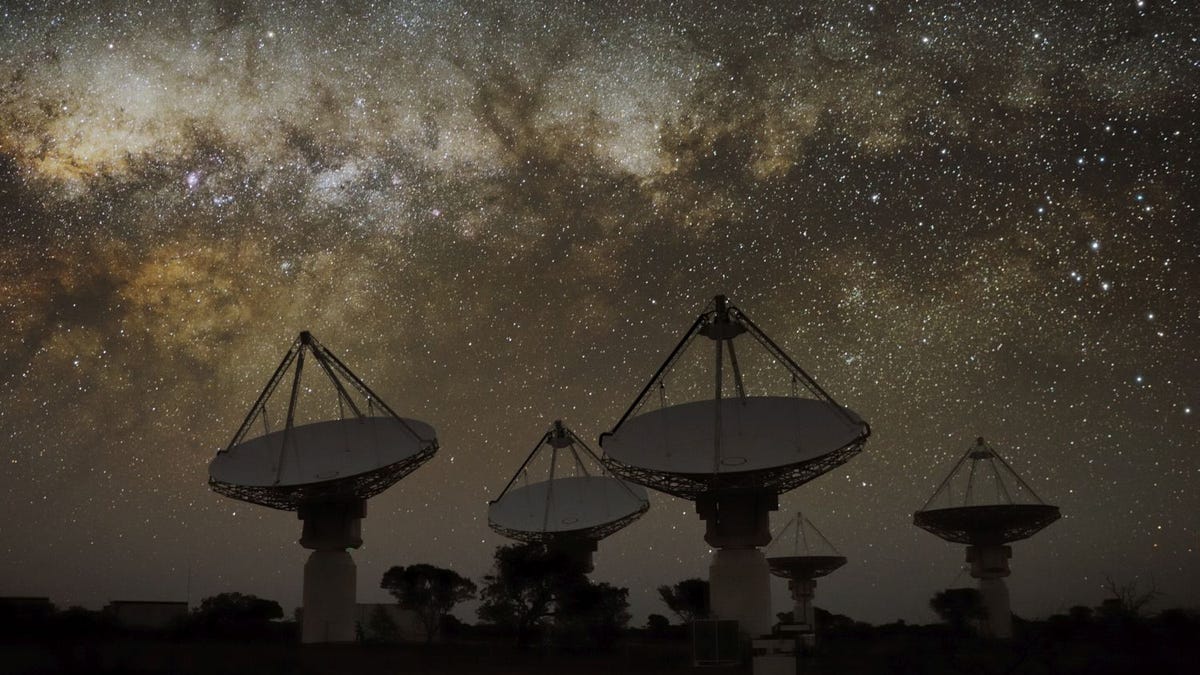New telescope has already found 3 rare mystery signals
The Australian Square Kilometre Array Pathfinder is poised to make history if it helps solve the origin of fast radio bursts.

The Australian Square Kilometre Array Pathfinder is already making tremendous leaps forward. Within four days of being switched on, the radio telescope array detected its first fast radio burst, or FRB.
These radio signals are an unsolved space mystery. Not only extremely powerful, they last just milliseconds. It is rare that they repeat, which makes them very hard to predict or locate. Until the Australian Square Kilometre Array Pathfinder (ASKAP) started scouring the skies, only 23 had ever been found and most of those were identified in previously recorded data.
The radio telescope array discovered not only one FRB, but three, and it only used eight of its 36 dishes.
"With ASKAP we can find an FRB every couple of days, and that number will increase very quickly now that we've got our technology working," said Keith Bannister of Australia's Commonwealth Scientific and Industrial Research Organisation (CSIRO), who led the research.
The key to the discovery is a new type of radio telescope technology called the "phased array feed." Most telescopes only look at one area of the sky at a time. The phased array feed, with each camera made up of 188 receivers, allows the researchers (from CSIRO, Curtin University and the International Centre for Radio Astronomy Research) to look at 240 square degrees of the sky, pointing the dishes in different directions.
It's this wide field of view that gives the ASKAP (and eventually the Square Kilometre Array, a telescope slated for 2020 made of thousands of dishes) the edge on FRB detection.
Could we solve the mystery?
The applications are huge for astronomers around the world.
Firstly, there's the statistics of the FRB population, such as the ratio of bright signals to faint ones. This will help show whether the FRBs are nearby or if they're affected by the age of the universe.
The signal of FRB 170107.
Secondly, the team will add an extra mode to help pinpoint with greater accuracy where the FRBs originate, which could finally explain what causes them.
The problem right now, Bannister said, is there's no theory that explains what has been observed.
"To make a fast radio burst and to make it visible, because it's coming from such a long way away, it has to be really bright," he said. "So if it's coming from so far away, then the question is how does something make something so bright that can be seen from so far away?"
He has a few ideas.
"The things that we know of that generate similar sorts of emissions are, for example, pulsars and magnetars."
But he said pulsars and magnetars can't be detected in other galaxies. "And yet we detect FRBs that we think are in other galaxies," he said. "So we think it's probably not the pulsars or the magnetars that we see normally. But then if it's not that, then what is it?"
The finding of the first FRB, called FRB170107, was published Monday in the journal The Astrophysical Journal Letters. The other two at time of writing are yet to be published. But they, and many others, will be coming soon, Bannister hopes.
"This is just the beginning for ASKAP and there's going be a lot more coming out of the telescope in the next 12 months."
CNET Magazine: Check out a sample of the stories in CNET's newsstand edition.
Logging Out: Welcome to the crossroads of online life and the afterlife.

